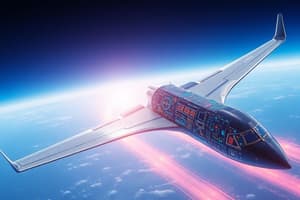Podcast
Questions and Answers
What is one of the primary advantages of the Integrated Modular Avionics (IMA) system?
What is one of the primary advantages of the Integrated Modular Avionics (IMA) system?
- Enhanced pilot workload
- Increased weight for better stability
- Reduced weight and size (correct)
- More complex wiring systems
What role does the data bus play in IMA systems?
What role does the data bus play in IMA systems?
- It increases pilot workload by requiring constant interaction.
- It functions independently from other systems.
- It primarily manages the physical weight of the aircraft.
- It acts as a communication pathway for data exchange among systems. (correct)
Which challenge is associated with the implementation of IMA systems?
Which challenge is associated with the implementation of IMA systems?
- Reduced operational costs
- User-friendly interfaces
- Simplifying modular designs
- Integrating new technologies with existing systems (correct)
How does the modular design of IMA systems benefit aircraft maintenance?
How does the modular design of IMA systems benefit aircraft maintenance?
What emerging technology is expected to enhance decision-making within IMA systems?
What emerging technology is expected to enhance decision-making within IMA systems?
Which factor contributes to the increased reliability of IMA systems?
Which factor contributes to the increased reliability of IMA systems?
What technology allows for remote monitoring and data analysis in IMA systems?
What technology allows for remote monitoring and data analysis in IMA systems?
What is a significant benefit of the standardized interfaces in IMA systems?
What is a significant benefit of the standardized interfaces in IMA systems?
What is one primary benefit of the Integrated Modular Avionics system?
What is one primary benefit of the Integrated Modular Avionics system?
Which feature contributes to the reduced weight in IMA systems?
Which feature contributes to the reduced weight in IMA systems?
How does the IMA system enhance aircraft safety?
How does the IMA system enhance aircraft safety?
What characteristic of IMA systems helps in improving maintenance efficiency?
What characteristic of IMA systems helps in improving maintenance efficiency?
Which aspect of IMA technology directly enhances aircraft performance?
Which aspect of IMA technology directly enhances aircraft performance?
What is the role of the common software platform in IMA systems?
What is the role of the common software platform in IMA systems?
What does the flexibility of IMA systems allow for?
What does the flexibility of IMA systems allow for?
Which of the following best describes the impact of IMA on training for pilots and maintenance crews?
Which of the following best describes the impact of IMA on training for pilots and maintenance crews?
Flashcards
Data Bus
Data Bus
A central channel where different aircraft systems share data and communicate with each other.
Modular Design
Modular Design
Each system within IMA is a self-contained unit that can be easily swapped or repaired.
Standardized Interfaces
Standardized Interfaces
Standardized communication protocols ensure different systems can understand and interact with each other.
Reduced Weight and Size
Reduced Weight and Size
Signup and view all the flashcards
Simplified Maintenance
Simplified Maintenance
Signup and view all the flashcards
Increased Reliability
Increased Reliability
Signup and view all the flashcards
Advanced Functionality
Advanced Functionality
Signup and view all the flashcards
Compatibility
Compatibility
Signup and view all the flashcards
Integrated Modular Avionics (IMA)
Integrated Modular Avionics (IMA)
Signup and view all the flashcards
Improved Reliability in IMA
Improved Reliability in IMA
Signup and view all the flashcards
Reduced Weight in IMA
Reduced Weight in IMA
Signup and view all the flashcards
Increased Efficiency in IMA
Increased Efficiency in IMA
Signup and view all the flashcards
Flexibility in IMA
Flexibility in IMA
Signup and view all the flashcards
Modular Architecture in IMA
Modular Architecture in IMA
Signup and view all the flashcards
Common Software Platform in IMA
Common Software Platform in IMA
Signup and view all the flashcards
Redundancy in IMA
Redundancy in IMA
Signup and view all the flashcards
Study Notes
Integrated Modular Avionics Systems: An Overview
- Integrated Modular Avionics (IMA) replaces separate aircraft systems with a unified, integrated architecture.
- This simplifies maintenance, reduces weight, and improves efficiency.
- IMA consolidates various functions (navigation, communication, engines) onto a single platform, minimizing individual units.
Benefits Of Integrated Modular Avionics (IMA)
- Improved Reliability: Multiple power sources for critical functions ensure continued operation during failure.
- Reduced Weight: Consolidating systems into a single unit reduces weight and enhances fuel efficiency.
- Increased Efficiency: Streamlined maintenance minimizes downtime and labor costs.
- Flexibility: IMA systems adapt to diverse aircraft models and designs.
Key components of the IMA System
- Modular Architecture: Separate modules perform specific functions.
- Common Software Platform: A single platform manages diverse modules, simplifying programming and updates.
- Redundancy: Redundant systems assure mission-critical functions even with failures.
The IMA System Impact on Aircraft Design
- Reduced Complexity: Simplifies design and engineering for lighter, more efficient aircraft.
- Improved Safety: Redundant systems and advanced monitoring bolster safety.
- Reduced Maintenance Costs: Combined systems streamline maintenance and troubleshooting.
The IMA System's Impact on Aircraft Operations and Maintenance
- Simplified Training: Fewer systems to learn, making pilot and maintenance training quicker and more efficient.
- Increased Availability: Reduces downtime for increased aircraft operational time.
- Improved Performance: Seamless integration and data sharing enhance overall aircraft performance.
The IMA System's Impact on Aircraft Technology
- Digital Flight Control: Integrates with modern digital flight control systems for enhanced safety and performance.
- Advanced Automation: Automates various aircraft systems, lessening pilot workload and improving safety.
- Networked Systems: Enables data exchange and collaboration between systems, enhancing pilot situational awareness.
IMA System: Key Concepts and Technologies
- Data Bus: A central data pathway for system communication.
- Modular Design: Each system is a replaceable module for easier repair and maintenance.
- Standardized Interfaces: Ensures interoperability between modules using communication and data exchange standards.
IMA System: Key Advantages
- Reduced Weight and Size: Consolidates systems and reduces connections for compact, lighter aircraft.
- Simplified Maintenance: Easily replaceable modules allow for quicker repairs and reduced downtime.
- Increased Reliability: Redundancy and fault tolerance make the system less susceptible to failures.
- Advanced Functionality: Data sharing enables complex, integrated tasks.
IMA System: Key Challenges
- Compatibility: Smooth integration of new technologies and existing avionics systems.
- Cybersecurity: Protecting the system from cyberattacks and unauthorized access.
- Complexity: Managing a highly integrated system demands careful planning and execution.
IMA System: Future Trends
- Artificial Intelligence (AI): AI integration enhances decision-making, improves safety, and optimizes performance.
- Cloud Computing: Enables remote monitoring and data analysis to optimize maintenance and flight operations.
- Internet of Things (IoT): Facilitates seamless communication between aircraft and ground teams for improved data exchange and efficiency.
Studying That Suits You
Use AI to generate personalized quizzes and flashcards to suit your learning preferences.




